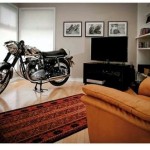How To Decorate a Big Room
Decorating a large room presents unique challenges and opportunities. The sheer scale can feel overwhelming, leading to a space that feels impersonal or disproportionate. However, with thoughtful planning and execution, a big room can become a stylish and inviting haven. This article outlines key strategies for effectively decorating a large room, ensuring a cohesive and comfortable atmosphere.
Define Zones and Functionality
One of the most crucial aspects of decorating a large room is to define distinct zones for different activities. A single, open space can easily feel chaotic without clear boundaries. Consider the room's intended use and break it down into functional areas. This could include a living area for relaxation and entertainment, a dining area for meals, a reading nook for quiet contemplation, or even a home office space.
Defining zones involves strategically arranging furniture to delineate each area. Use rugs to anchor each zone, providing visual boundaries and warmth underfoot. For example, a large area rug under the sofa, coffee table, and armchairs defines the living area. Similarly, a rug beneath the dining table and chairs establishes the dining zone. These rugs should be appropriately sized to create a sense of proportion within their respective areas. Ensure enough rug extends under the furniture to avoid a floating or detached appearance. The size of the rug should be carefully considered to be proportional to the furniture and the zone it is defining.
Furniture placement is also key in defining zones. Arrange sofas and chairs to face each other, creating a conversational grouping in the living area. Position a bookshelf or console table to act as a visual divider between the living and dining areas. Consider using screens or partitions to create more defined separation if needed, allowing for more private or intimate spaces within the larger room. The height and style of these dividers should complement the overall aesthetic of the room.
Lighting plays a vital role in reinforcing zone definitions. Utilize different types of lighting for each area depending on its function. A bright overhead fixture might be suitable for the dining area, while softer, ambient lighting from lamps and sconces is preferable in the living area. Task lighting, such as a floor lamp near a reading chair, provides direct illumination for specific activities. Varying lighting levels and types contributes to the overall ambiance and helps to visually separate the zones.
Color can also be used to subtly define zones. While maintaining a cohesive color palette throughout the room is important, variations in shade and accent colors can help to distinguish each area. For example, the living area could feature a slightly warmer color palette than the dining area, creating a more inviting and intimate atmosphere. Consider using accent pillows, throws, and artwork in different colors to further reinforce the zone definitions.
Scale and Proportion
Given the expansive nature of a large room, it is essential to choose furniture and accessories that are appropriately scaled to the space. Smaller pieces can get lost and create a visual imbalance, leading to a room that feels empty and uninviting. Opt for larger, more substantial furniture that can hold its own in the expansive space. This includes oversized sofas, generously sized armchairs, and a substantial coffee table. Avoid delicate or petite furniture that may appear dwarfed by the surrounding area.
Artwork and wall decor should also be chosen with scale in mind. A single, small piece of art on a large wall will look insignificant. Instead, consider grouping several smaller pieces together to create a gallery wall or opting for one or two large-scale artworks. Mirrors can also be used strategically to enhance the sense of space and reflect light, making the room feel even larger and brighter. However, avoid placing mirrors in areas that reflect clutter or unattractive views.
When selecting rugs, ensure they are large enough to anchor the furniture grouping within each zone. A rug that is too small will make the space feel disjointed. Ideally, the rug should extend at least a few feet beyond the furniture on all sides. If purchasing a rug large enough isn't feasible, consider layering a smaller rug on top of a larger, neutral rug to add texture and visual interest.
Window treatments are another area where scale is essential. Avoid flimsy or undersized curtains that will look out of place in a large room. Instead, opt for full-length drapes that reach the floor and extend beyond the window frame. This will not only add visual height to the room but also help to frame the windows and create a more dramatic effect. Choose fabrics with sufficient weight and texture to complement the scale of the room.
Accessories, such as lamps, vases, and decorative objects, should also be chosen with scale in mind. Avoid overly delicate or dainty items that will get lost in the vastness of the room. Instead, opt for larger, more substantial pieces that can make a statement. Grouping accessories together can also help to create a sense of visual impact. For example, arrange a collection of large vases on a console table or display a group of oversized candles on a mantelpiece.
Creating Cohesion and Visual Interest
While defining zones is important, it is equally crucial to maintain a sense of cohesion throughout the large room. Avoid creating disparate areas that feel disconnected from one another. A consistent color palette, shared design elements, and a unifying theme can help to tie the zones together and create a harmonious overall aesthetic. While variations in shade and accent colors are acceptable, maintain a common thread throughout the room to ensure visual continuity.
Introducing texture is key to adding visual interest and preventing a large room from feeling sterile or bland. Incorporate a variety of textures through fabrics, materials, and finishes. Layer different textures in each zone to create depth and dimension. For example, in the living area, combine a plush velvet sofa with linen throw pillows, a woven rug, and a textured coffee table. In the dining area, pair a smooth wood table with upholstered chairs and a woven runner. The interplay of different textures will add warmth and character to the space.
Pattern is another effective way to add visual interest. Use patterns in rugs, curtains, upholstery, and wallpaper. However, avoid overwhelming the room with too many competing patterns. Choose one or two dominant patterns and then incorporate smaller, more subtle patterns as accents. Consider the scale of the patterns in relation to the size of the room. Larger patterns can work well in large rooms, while smaller patterns may be more suitable for smaller spaces. Varying the scale of the patterns used will help to create a dynamic and visually engaging space.
Artwork and accessories are essential for adding personality and character to the room. Choose pieces that reflect personal taste and interests. Displaying a curated collection of artwork, photographs, and travel souvenirs can help to make the room feel more personal and inviting. Arrange accessories in vignettes to create visual interest and tell a story. Consider displaying books, vases, candles, and other objects on shelves, mantelpieces, and coffee tables. The arrangement of these items can further enhance the overall aesthetic of the room.
Lighting plays a crucial role in creating both ambiance and visual interest. Use a combination of ambient, task, and accent lighting to illuminate the room effectively. Ambient lighting provides overall illumination, while task lighting provides focused light for specific activities. Accent lighting is used to highlight architectural features, artwork, or accessories. Incorporate a variety of lighting fixtures, such as chandeliers, pendants, sconces, floor lamps, and table lamps, to create a layered and dynamic lighting scheme. Dimmers can be used to adjust the lighting levels and create different moods.

10 Tips For Styling Large Living Rooms Other Awkward Spaces The Inspired Room

9 Tips To Help Decorate Large Spaces Real Estate Hsa

13 Tricks To Decorating A Large Living Room

How To Decorate A Large Living Room Ruggable Blog

10 Tips For Styling Large Living Rooms Other Awkward Spaces The Inspired Room
:max_bytes(150000):strip_icc()/11-66b11109b02546c28af189878c0508e7.png?strip=all)
30 Great Rooms Ideas That Ll Make You Want To Host Asap

Great Secrets Of Rooms Hints For Decorating A Large Space Sheknows

10 Tips For Styling Large Living Rooms Other Awkward Spaces The Inspired Room

How To Decorate A Large Living Room Peninsula

How To Decorate A Large Living Room Make It Feel Cosy
Related Posts







